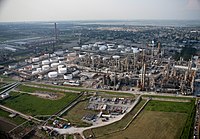
Photo from wikipedia
Abstract For the oxide-based photocatalysts, polyoxylic acid modification can affect their adsorption/desorption properties and further regulate photocatalytic reaction pathway, which is crucial for enhancing photocatalytic activity and selectivity. Herein, phosphoric… Click to show full abstract
Abstract For the oxide-based photocatalysts, polyoxylic acid modification can affect their adsorption/desorption properties and further regulate photocatalytic reaction pathway, which is crucial for enhancing photocatalytic activity and selectivity. Herein, phosphoric acid modified TiO2 was synthesized by a facile impregnation-calcination method for photocatalytic degradation of gaseous o-xylene. According to FTIR, XPS, and EDS analysis, phosphoric acid was anchored on the surface of TiO2 successfully. The surface P atomic percentages for PT1 was 2.45%. The as-prepared phosphoric acid modified TiO2 (PTx) had a photocatalytic performance superior to that of commercial TiO2 and unmodified TiO2 (PT0), with increasing by 2.2 times at most. Interestingly, the phosphoric acid molecules strongly adsorbed on anatase TiO2 surface by forming H–O2C and =O–Ti5C chemical bonds according to the first principle calculations, which changed TiO2 surface properties (specific surface area and surface negative electrostatic field) and further improved adsorption and charge carrier separation and transfer, thus improving the photocatalytic activity. Additionally, according to the intermediates results, the relative abundance of intermediates shows obvious difference. Acetone was detected as the most abundant intermediates during o-xylene degradation for PT0, whereas that was o-methyl benzaldehyde for PT1, which could be ascribed to the difference of surface adsorption configuration of o-xylene. According to the temperature-programmed desorption (TPD) results, the surface modified by phosphoric acid could change the o-xylene adsorption configuration to favor its methyl oxidation (standing configuration), whereas the unmodified surface could be more favorable to the benzene ring-open reaction (lying configuration). This work will deepen the understanding of the relevance of surface modification and surface photocatalytic reaction, which also provides a feasible strategy to improve photocatalytic selectivity.
Journal Title: Chemical Engineering Journal
Year Published: 2020
Link to full text (if available)
Share on Social Media: Sign Up to like & get
recommendations!